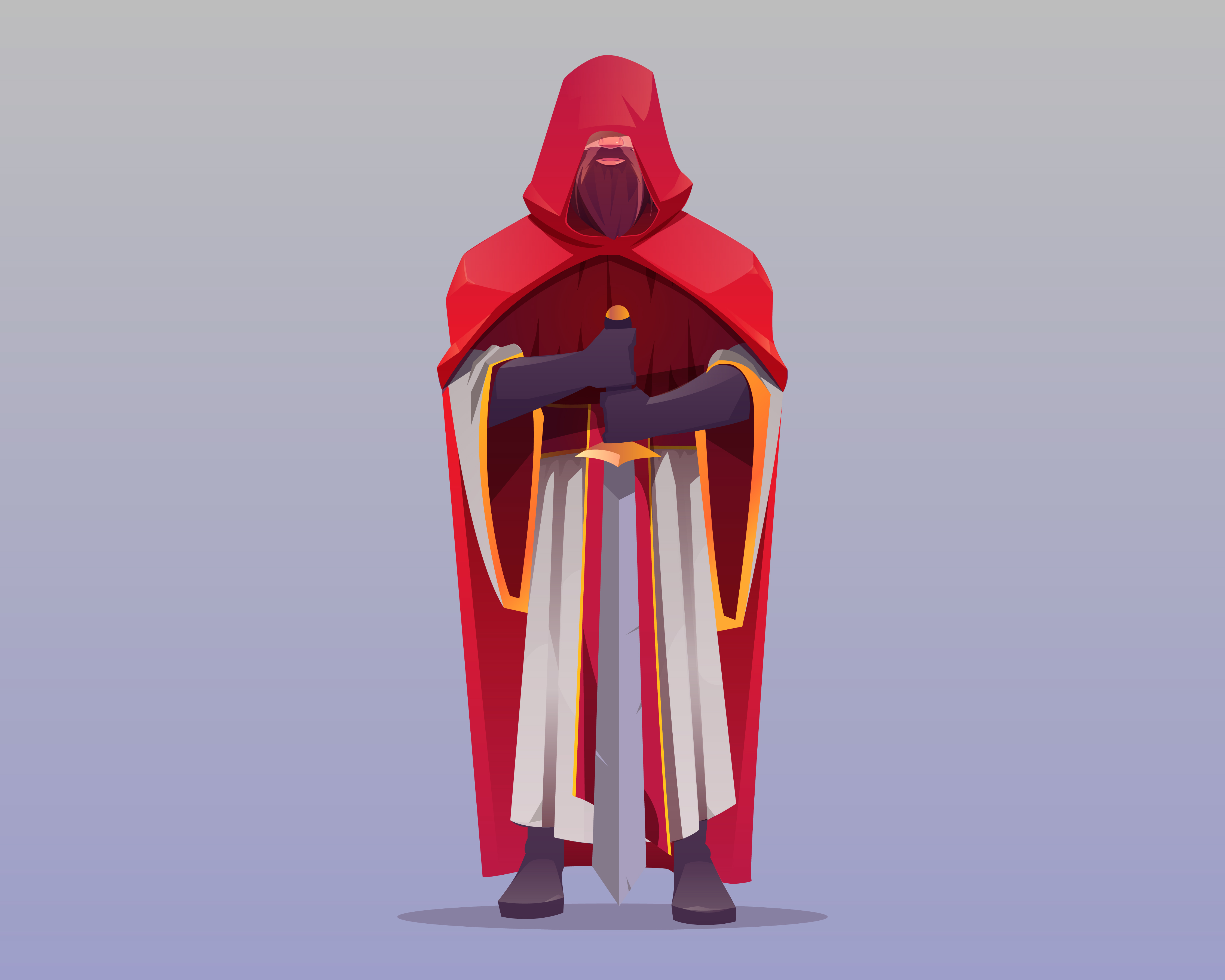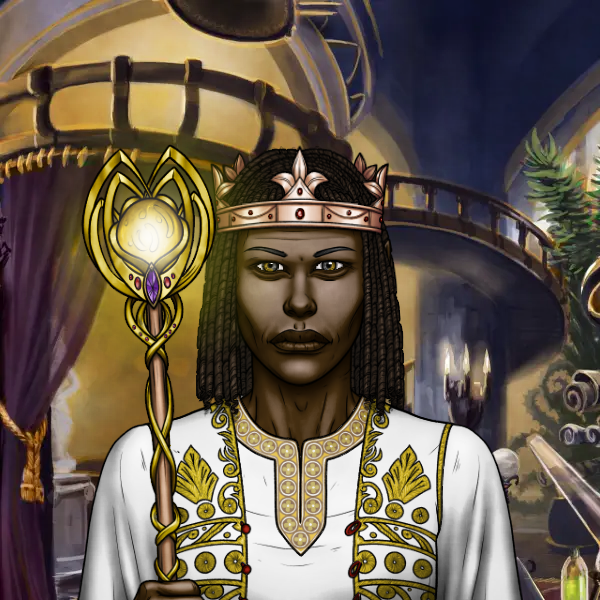Mvurjdi (Mv-ur-JD-e)
The Blood-Soaked Streets of Gold
Ev’rybody sees green when servin’ the nobility. Don’t get me wrong, it’d sure be nice to be draped in gold with glistenin’ slaves fanning away the high sun heat. But then I’d hav’ta worry about the sacrifices. Let me stay in the kitchens. My hands may be rough, but at least they’re not reachin’ for a sword.Nestled below the Rose Sea at the northern edge of the Mesa Dune Desert is the capital city of Mvurjdi. Decadence lines the gold-cobbled streets with homes inlayed with rubies and emeralds. The shining beacon at the center of Mvurjdi is the Gold Palace of Zuvmurt. Beneath the outward appearance of splendor lays a more sinister truth.
Citizens and Class
Mvurjdi, like most of Zuvmurt Kingdom, is highly stratified. Forty-five percent of the city’s inhabitants are slaves. Many were brought to Mvurjdi as prisoners of war. Others were born into slavery. The slave population consists of dragonborns, half-elves, halflings, humans, and orcs. It is rare to find a slave elf in the Zuvmurt Kingdom. However, when an elf is forced into slavery any pure elf children they have are granted freedom at birth. Additionally, elf slaves work directly for highest noble families and are often ‘gifted’ freedom through loyal service. Slaves in Zuvmurt Kingdom have little say in their dress. Any clothing, weapons, or items they possess are taken from them and each slave carries a black brand which indicates the Zuvmurt Kingdom and the noble family who owns them. Slaves are provided with two pairs of plain cotton tunics with sherwal pants and surprisingly durable shoes. Directly above the slave class are the working class and artisan elves; they make up about twenty-five percent of the population. This class provides craft and entertainment for the noble families, as well as manage agriculture and trade in the city. Many of these elves have homes or family in the outer provinces. Often, they are in the city for seasonal work or trade. In order to remain in the city, elves must procure a letter of invitation from a noble family. The artisan and working class often emulate the nobility style of dress. They wear tunics and djellabas of practical cotton or linen with dyed gold threaded designs. Gold plated or painted jewelry is worn frequently. As a result, some of the working class elves have green stains on their ears and hands. The noble families are around twenty-five percent of the population. A life of ease and untold wealth, each noble family carries the curse of The Rapacious. Every New Moon, two randomly chosen Nobles must battle for their life and soul. The souls The Rapacious chooses are often siblings or lovers. No noble elf is safe, not even the King Turgesa. Nobles in Zuvmurt Kingdom wear pure gold masks. Men's masks represent different animals. Whereas, women wear gold visors which cover their eyes and forehead. The visors have intricate carved designs. Long and loose tunics with hoods are preferred for both men and women, as it keeps them cool in the desert sun. Gold patterns, marking their noble lines, are embroidered into silk djellabas and caftans. The top five percent of the population are the tieflings, who are the direct messengers of The Rapacious. They serve as priests of the Cult of Rapacious and as enforcers. Unlike the decadent dress of the Noble Elves, the tiefling class adorns themselves with no gold. Instead, they dress in black and red leather tunics and robes - as if to proclaim, the Desert sun holds no sway. Within the city walls, only tieflings are permitted to carry weapons. The majority of the tieflings in Mvurjdi are priests and enforcers of The Cult of Rapacious. However, there are tiefling descendants within the nobility and artisan classes.Religion and War
The Cult of Rapacious is the official State religion and the only sanctioned religion in Zuvmurt Kingdom. Only the tiefling priests are able to speak for Rapacious and the primary mission of the Cult is to collect souls through strife. Daily Tournament Sacrifices are a means of worship and a form of entertainment for those in Mvurjdi. Most of these tournaments pit captured slaves against one another. However, law breakers run the risk of being drafted for the Sacrifice. On each New Moon, Rapacious hand-selects two noble elves for the New Moon Tournament Sacrifice. Silent, behind a leather mask, Rapacious watches the New Moon Tournaments from a box above the King’s. The Cult of Rapacious also demands war and expansion. The pride of warriors is indoctrinated in schools and intoned in bedtime stories. To enlist in war and bring back two slaves is one of the only avenues for a slave to earn their freedom. Most of the pampered noble elves only experience the spoils of war through additional slaves for their families and resources pillaged from outlaying settlements. However, many nobles enlist as officers to seek glory and claim more land for their family. Whispers of the old religion of Zuvmut can be heard in those secret places hidden away from the watchful eyes of tiefling enforcers. However, nobody would dare be caught with his symbol for pain of Tournament Sacrifice.Agriculture and Trade
Outside the city walls, agricultural provinces provide food for the Noble and Artisan classes of elves. The working and slave classes are expected to provide food for themselves through personal gardens and local trade and markets. One popular food export is Rejuvenating Dates, through use of a secret farming method. agricultural elves spliced a date that allows for the consumer to forgo trance or sleep for an additional night without exhaustion. Mvurjdi is the center of the feudal-based kingdom and all outside provinces must pay taxes or tributaries in order to keep their lands. The two highest exported goods in the Kingdom are gold and pink salt. Pink Salt is especially desired on the Western Continent, where Noble Families trade for secrets and MagiTech. The Artisan class also weaves highly sought-after textiles, which are gathered from silk worms that are fed a diet of mithral shavings. Mvurjdi's largest trade partner is the Thorbilje Dynasty. The only State that the Noble Families have legitimized. All trade agreements must go through the Noble families of Mvurjdi before they are legitimatized.King Turgesa III is the second monarch to rule since the ascension of Rapacious. Fifty years prior, King Turgesa II was selected for the New Moon Tournament Sacrifice. His Opponent? His beloved wife.
The Queen, driven mad from the death of the King, was never seen again. Presumed dead, it is rumored that on the night of the New Moon she walks the gold cobblestones of Mvurjdi murdering young lovers who dare find joy.
Walls
Mvurjdi is as much a city of war as it is the city of gold. The walls, though beautiful with intricate gemstone mosaics, serve to keep people out. And more importantly, keep folk in. A letter of invitation is the only way to enter the city. But beware angering the wrong noble family or messenger. Not only may you find yourself trapped in blood-soaked paradise, but your name could be drawn for the Tournament Sacrifice.
 Demographics
Demographics

by Upklyak
Messengers: Tieflings -- 5%
Noble Families: Elves, Tieflings -- 25%
Artisan Class: Elves, Tieflings -- 10%
Working Class Elves -- 15%
Slave Class: Dragonborns, Half-Elves, Halflings, Humans, Orcs -- 45%
Elven NativesSkin Tone: Medium to dark brown
Eyes: Monolid in shades of green and brown
Hair: Curly to kinky in shades of black, brown, and red




Comments